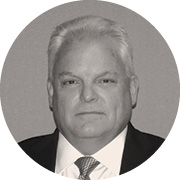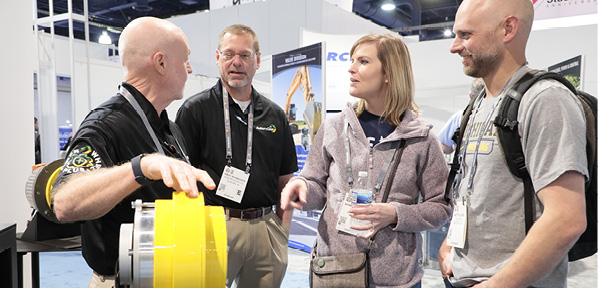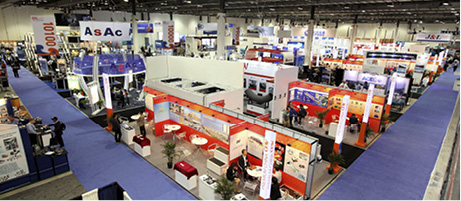2015 Mobile Market Q & A
 Gary Gotting moved from Sussex, England, to the United States 15 years ago and has more than 30 years of experience in the fluid power industry and electro-hydraulics international arena, holding roles of increasing responsibility in various design, manufacturing, sales, and marketing positions. In 2013, Mr. Gotting moved to Sun Hydraulics Corp. in Sarasota, Fla. to take up a senior position in the marketing area promoting all aspects of the company’s cartridge valves, controllers, and integrated package products.
Gary Gotting moved from Sussex, England, to the United States 15 years ago and has more than 30 years of experience in the fluid power industry and electro-hydraulics international arena, holding roles of increasing responsibility in various design, manufacturing, sales, and marketing positions. In 2013, Mr. Gotting moved to Sun Hydraulics Corp. in Sarasota, Fla. to take up a senior position in the marketing area promoting all aspects of the company’s cartridge valves, controllers, and integrated package products.
 Dave Stagg graduated from the University of New Mexico with a degree in economics. He started working in the fluid power industry in 1976 purely by accident. Mr. Stagg has spent the majority of his career involved in mobile hydraulic sales through distribution, and he currently works for HAWE Hydraulics as the western regional sales manager.
Dave Stagg graduated from the University of New Mexico with a degree in economics. He started working in the fluid power industry in 1976 purely by accident. Mr. Stagg has spent the majority of his career involved in mobile hydraulic sales through distribution, and he currently works for HAWE Hydraulics as the western regional sales manager.
 Jeff Finch is senior vice president and general manager for Eaton Hydraulics Products and Markets. He leads a high-performance global team of product management, engineering, business development, program management, and other professionals responsible for profitably growing the hydraulics business. Mr. Finch is an active participant in the Association for Hose and Accessories Distribution and the National Fluid Power Association.
Jeff Finch is senior vice president and general manager for Eaton Hydraulics Products and Markets. He leads a high-performance global team of product management, engineering, business development, program management, and other professionals responsible for profitably growing the hydraulics business. Mr. Finch is an active participant in the Association for Hose and Accessories Distribution and the National Fluid Power Association.
 Rick Sporrer, CFPHS, is vice president of sales (Americas) for Danfoss Power Solutions. He is responsible for the sales organization in North and South America, including account management, order management, systems and application engineering, and warranty administration. Mr. Sporrer has held positions in design engineering, applications engineering, account management, warranty administration, quality, and continuous improvement during his 24 years with the company.
Rick Sporrer, CFPHS, is vice president of sales (Americas) for Danfoss Power Solutions. He is responsible for the sales organization in North and South America, including account management, order management, systems and application engineering, and warranty administration. Mr. Sporrer has held positions in design engineering, applications engineering, account management, warranty administration, quality, and continuous improvement during his 24 years with the company.
What areas of growth or opportunity do you see developing in 2015 for the domestic/international mobile market?
Gotting: Following and supporting OEM customers that expand to other countries, and offering new products that allow opening new markets in different global arenas.
Stagg: In 2015, there are opportunities in agricultural equipment. There is an increasing demand for more mechanized fruit harvesting equipment due to the rising labor rates and lack of workers available to do the work.
Finch: Many are still struggling with how to view the markets since the great recession. We’ve seen more volatility and more of a mixed bag globally. However, amidst all that volatility, the macro trends favor our industry—from rising food production needs, to efficiency increases and carbon footprint reductions, and increased needs for intelligent machines to make job sites more productive and safe. Coming down from the macro to the street level, that same volatility and uncertainty is driving our customers to look for innovative solutions and move beyond the status quo.
One direction the market has followed is the development of more intelligent systems, and that is certainly the case for Eaton products, as well. The concept of electro-hydraulics, instead of purely hydraulic or mechanical hydraulic solutions, is developing across the industry. For example, advanced mobile valves with built-in electronics allow for onboard pressure sensing and internal position sensing. These electronic technologies have built-in software for pre-loaded functions, which are built into valves to control specific machine functions.
Another opportunity lies in complete hydraulic system solutions, which are becoming more popular with original equipment manufacturers (OEMs) who today want an entire system that works seamlessly together.
Sporrer: Most economists are expecting the U.S. economy to expand about 3% in 2015. If accurate, it would be the first year of 3% growth since 2005. Economic growth and the production and consumption of goods are a positive indicator for the material handling equipment market. The continued steady increase in single-family housing starts, coupled with the recent lowering of mortgage interest rates, are positive indicators for the construction equipment business in North America.
In 2014, the U.S. government announced an initiative to increase investment in ports, roads, bridges, broadband networks, and drinking water and sewer systems by facilitating partnerships between federal, state, and local governments and private sector investors. More recently, the government announced a new set of infrastructure tax proposals that will improve the ability to combine public and private investment so that local and state governments can more easily work with the private sector to advance the public interest. This effort is a positive indicator for the construction, road building, and material handling markets.
Mobile equipment manufacturers will continue to invest in technologies that provide differentiation and increase the value to the end customer. One such solution is telematics, and we anticipate that smaller OEMs will continue to follow the lead of larger OEMs in telematics-enabled machinery this year.
Internationally, safety regulations in Europe have driven and will continue to drive development of solutions to help customers meet the safety requirements.
What challenges (in terms of technology, regulations, efficiency, productivity, etc.) will the mobile market face in the upcoming year, and what does the industry need to do to handle these challenges?
Gotting: Simplified but smart products; an increase in bundled technology; simpler-to-apply integrated solutions that are more compact, lighter, and easier to integrate; dock-to-stock requirements from customers to provide better inventory control; and lead times that are less than four weeks.
Stagg: The Tier 4 engine regulations and talk of a potential Tier 5 requirement are a large source of concern for mobile OEMs. These regulations require extensive machine redesign and add significant cost to the machines. I am not sure that the industry can impact these new regulations.
Finch: Regulations have had a tremendous impact on the industry for the past decade. Tier 4 requirements drove a tremendous amount of cost, but also drove (and is still driving) innovation. From a mobile machine standpoint, it’s very interesting to participate in the evolution of the technology. We are making a rapid leap toward more advanced machines, and that’s just the start. From purely mechanical, to a mix of central and distributed intelligence, to fully intelligent components that are plug and play, the most exciting aspect as we move up that technology curve is that we are closing in on fluid power technologies and intelligence that is much easier for the designer to apply, invisible to the operators, and easier for the technicians who work on them. With connected machinery, productivity is beginning to take off.
Another challenge of interest is the productivity of our customers. When discussing productivity, our industry tends to focus on the productivity of the machine end user, but we must also be aware of the productivity of OEMs who are designing, building, and servicing machines. Easier-to-use software, built-in function blocks, on-board sensing and diagnostics, and self-calibrating plug-and-play components for easy replacement are all examples that are helping make their selection, design, prototyping, and production processes much faster and more efficient.
Safety requirements have also risen to the forefront, as Safety Integrity Level (SIL) mandates require components and system design to have certain capabilities to provide adequate machine safeguards. Customers are now looking to OEMs and component suppliers to help meet SIL capabilities.
Finally, across many types of equipment, customers are looking for increased hose performance. Pressures are going higher (500-bar pressure is not uncommon for closed-loop transmissions), and reliable hoses can be key to equipment uptime. To extend hose life and meet these pressure challenges, we’re working to improve abrasion resistance and provide better flexibility for ease of installation.
Sporrer: For years, mobile equipment manufacturers have been devoting the majority of their engineering resources to Tier 4 engine integration. Engineering organizations are now being challenged to bring on a new wave of innovation and offset cost increases associated with Tier 4. To accomplish this more quickly and efficiently, equipment manufacturers and suppliers must identify ways to work together.
Another challenge that exists in the industry is the overall experience level of engineering groups. Many equipment manufacturers do not have the engineering capacity for specialization in hydraulics and electronic controls.
Finally, attracting and retaining experienced manufacturing support personnel is stretching our supply base resources. Improvements in manufacturing productivity and the implementation of new manufacturing technologies are typically paced by the availability of supplier resources and/or our own experienced team members. Improving our ability to share best practices globally will help us leverage the experience of our teams.

How can the mobile market ensure the longevity of its workforce and attract young people into the field?
Gotting: More colleges offering mechatronics courses, re-training, and the introduction of smart products that combine hydraulics with electronic controllers that are interesting, captivating, and familiar to many young people who use high-tech and visual indicators in their daily lives with ease.
Stagg: The mobile market can attract young people by supporting existing schools that offer degrees in fluid power, visit and recruit from these schools, and offer apprenticeship programs to students. Keeping pay rates in line with other professions in competitive markets will also contribute to longevity in the workforce.
Finch: The convergence of electronics and hydraulics is continually reinventing the industry, leveraging new innovations to change the dynamics of fluid power technology—which is, in turn, creating a more innovative and thus more attractive field. Promoting this evolving industry will help build a better perception of fluid power—from leaky and noisy machines of old to the mechatronics and complete machine design we work on today. Another step is catching students in K-12 to promote our evolving field and to get young people excited before they reach the university level.
Sporrer: We need to continue to explore opportunities to increase the flexibility of our workforce. Our colleagues in Europe are fortunate to have apprenticeship programs that allow them to focus on training individuals with the desire to build a career in the mobile sector. In the U.S., we need to find ways to encourage younger individuals preparing to enter the workforce to strive for longer-term careers in the field.
The mobile market can improve in this area by teaming with and supporting educational partners. By working with schools and universities, we can point out the types of career potential and technology available in the industry. Providing support for organizations like Project Lead the Way (https://www.pltw.org) and First Lego League (http://www.firstlegoleague.org/) are excellent ways that our industry can help attract the next generation of talent to our industry.
How can the mobile market remain competitive in 2015 and in the future?
Gotting: Design smarter products that interface directly with vehicle infrastructures, wireless configuration, access via smart devices to allow in-field set-up, configuration, test, and diagnostics. Look to add prognostics for preventive maintenance, and start to fall in line with expectations set by the automotive industry for interconnectivity.
Stagg: The mobile market can remain competitive by continuing to invest in the latest manufacturing technology, thus maintaining a competitive price in the marketplace. These technologies will also allow us to offer high-quality products that are superior to those coming out of China.
Finch: Continuing development around complete machine solutions is one of the best ways to take advantage of the benefits and capabilities of fluid power. Mobile equipment users across industries are looking for larger, faster, more powerful machines across the board, with increasing pressure and flow rates, as well as power density. As engine efficiency grows, hydraulics can help maximize machine power.
At the same time, customers are looking for ease of maintenance to help keep these big investments up and running. Integrating electronics with traditional hydraulic solutions—from valves to hoses and more—provides much needed monitoring and reporting. When customers can easily determine when preventive maintenance is needed before a machine breaks down, they are getting the most out of their machines. These and other creative and intelligent ways to manage power can help the industry thrive. By focusing on the needs of everyone in the value chain, the market can continue to innovate and grow.
Sporrer: Companies in the mobile market segment can compete and endure by understanding and adapting to the interests and needs of the different generations that exist in our business. I have observed a number of companies adjusting their work environments so that communication tools and learning opportunities are targeted for each generation.
In today’s global market, regulatory challenges and easy access to information require even small companies to think globally. Companies can stay viable in their competitive climate with commitment to innovative technologies and responsiveness to customer needs.







